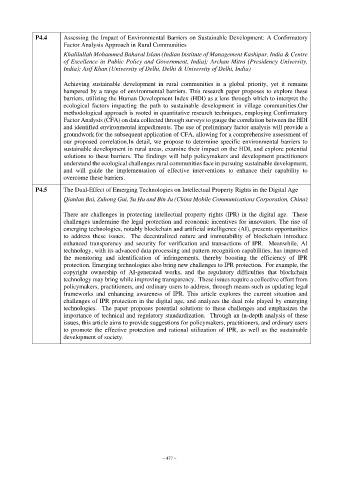Page 521 - Kaleidoscope Academic Conference Proceedings 2024
P. 521
P4.4 Assessing the Impact of Environmental Barriers on Sustainable Development: A Confirmatory
Factor Analysis Approach in Rural Communities
Khalilullah Mohammed Baharul Islam (Indian Institute of Management Kashipur, India & Centre
of Excellence in Public Policy and Government, India); Archan Mitra (Presidency University,
India); Asif Khan (University of Delhi, Delhi & University of Delhi, India)
Achieving sustainable development in rural communities is a global priority, yet it remains
hampered by a range of environmental barriers. This research paper proposes to explore these
barriers, utilizing the Human Development Index (HDI) as a lens through which to interpret the
ecological factors impacting the path to sustainable development in village communities.Our
methodological approach is rooted in quantitative research techniques, employing Confirmatory
Factor Analysis (CFA) on data collected through surveys to gauge the correlation between the HDI
and identified environmental impediments. The use of preliminary factor analysis will provide a
groundwork for the subsequent application of CFA, allowing for a comprehensive assessment of
our proposed correlation.In detail, we propose to determine specific environmental barriers to
sustainable development in rural areas, examine their impact on the HDI, and explore potential
solutions to these barriers. The findings will help policymakers and development practitioners
understand the ecological challenges rural communities face in pursuing sustainable development,
and will guide the implementation of effective interventions to enhance their capability to
overcome these barriers.
P4.5 The Dual-Effect of Emerging Technologies on Intellectual Property Rights in the Digital Age
Qianlan Bai, Zuhong Gui, Su Hu and Bin Ju (China Mobile Communications Corporation, China)
There are challenges in protecting intellectual property rights (IPR) in the digital age. These
challenges undermine the legal protection and economic incentives for innovators. The rise of
emerging technologies, notably blockchain and artificial intelligence (AI), presents opportunities
to address these issues. The decentralized nature and immutability of blockchain introduce
enhanced transparency and security for verification and transactions of IPR. Meanwhile, AI
technology, with its advanced data processing and pattern recognition capabilities, has improved
the monitoring and identification of infringements, thereby boosting the efficiency of IPR
protection. Emerging technologies also bring new challenges to IPR protection. For example, the
copyright ownership of AI-generated works, and the regulatory difficulties that blockchain
technology may bring while improving transparency. These issues require a collective effort from
policymakers, practitioners, and ordinary users to address, through means such as updating legal
frameworks and enhancing awareness of IPR. This article explores the current situation and
challenges of IPR protection in the digital age, and analyzes the dual role played by emerging
technologies. The paper proposes potential solutions to these challenges and emphasizes the
importance of technical and regulatory standardization. Through an in-depth analysis of these
issues, this article aims to provide suggestions for policymakers, practitioners, and ordinary users
to promote the effective protection and rational utilization of IPR, as well as the sustainable
development of society.
– 477 –

